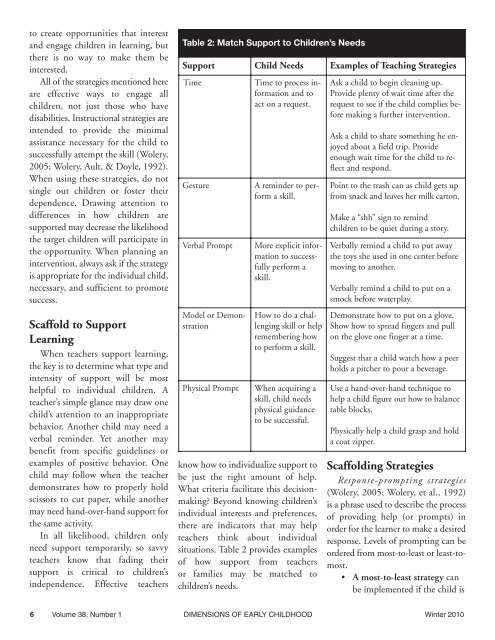90223 Dimensions Winter 10:Layout 1 - Southern Early Childhood ...
90223 Dimensions Winter 10:Layout 1 - Southern Early Childhood ...
90223 Dimensions Winter 10:Layout 1 - Southern Early Childhood ...
You also want an ePaper? Increase the reach of your titles
YUMPU automatically turns print PDFs into web optimized ePapers that Google loves.
to create opportunities that interest<br />
and engage children in learning, but<br />
there is no way to make them be<br />
interested.<br />
All of the strategies mentioned here<br />
are effective ways to engage all<br />
children, not just those who have<br />
disabilities. Instructional strategies are<br />
intended to provide the minimal<br />
assistance necessary for the child to<br />
successfully attempt the skill (Wolery,<br />
2005; Wolery, Ault, & Doyle, 1992).<br />
When using these strategies, do not<br />
single out children or foster their<br />
dependence. Drawing attention to<br />
differences in how children are<br />
supported may decrease the likelihood<br />
the target children will participate in<br />
the opportunity. When planning an<br />
intervention, always ask if the strategy<br />
is appropriate for the individual child,<br />
necessary, and sufficient to promote<br />
success.<br />
Scaffold to Support<br />
Learning<br />
When teachers support learning,<br />
the key is to determine what type and<br />
intensity of support will be most<br />
helpful to individual children. A<br />
teacher’s simple glance may draw one<br />
child’s attention to an inappropriate<br />
behavior. Another child may need a<br />
verbal reminder. Yet another may<br />
benefit from specific guidelines or<br />
examples of positive behavior. One<br />
child may follow when the teacher<br />
demonstrates how to properly hold<br />
scissors to cut paper, while another<br />
may need hand-over-hand support for<br />
the same activity.<br />
In all likelihood, children only<br />
need support temporarily, so savvy<br />
teachers know that fading their<br />
support is critical to children’s<br />
independence. Effective teachers<br />
Table 2: Match Support to Children’s Needs<br />
Support Child Needs Examples of Teaching Strategies<br />
Time<br />
Gesture<br />
Verbal Prompt<br />
Model or Demonstration<br />
Physical Prompt<br />
Time to process information<br />
and to<br />
act on a request.<br />
A reminder to perform<br />
a skill.<br />
More explicit information<br />
to successfully<br />
perform a<br />
skill.<br />
How to do a challenging<br />
skill or help<br />
remembering how<br />
to perform a skill.<br />
When acquiring a<br />
skill, child needs<br />
physical guidance<br />
to be successful.<br />
know how to individualize support to<br />
be just the right amount of help.<br />
What criteria facilitate this decisionmaking?<br />
Beyond knowing children’s<br />
individual interests and preferences,<br />
there are indicators that may help<br />
teachers think about individual<br />
situations. Table 2 provides examples<br />
of how support from teachers<br />
or families may be matched to<br />
children’s needs.<br />
Ask a child to begin cleaning up.<br />
Provide plenty of wait time after the<br />
request to see if the child complies before<br />
making a further intervention.<br />
Ask a child to share something he enjoyed<br />
about a field trip. Provide<br />
enough wait time for the child to reflect<br />
and respond.<br />
Point to the trash can as child gets up<br />
from snack and leaves her milk carton.<br />
Make a “shh” sign to remind<br />
children to be quiet during a story.<br />
Verbally remind a child to put away<br />
the toys she used in one center before<br />
moving to another.<br />
Verbally remind a child to put on a<br />
smock before waterplay.<br />
Demonstrate how to put on a glove.<br />
Show how to spread fingers and pull<br />
on the glove one finger at a time.<br />
Suggest that a child watch how a peer<br />
holds a pitcher to pour a beverage.<br />
Use a hand-over-hand technique to<br />
help a child figure out how to balance<br />
table blocks.<br />
Physically help a child grasp and hold<br />
a coat zipper.<br />
Scaffolding Strategies<br />
Response-prompting strategies<br />
(Wolery, 2005; Wolery, et al., 1992)<br />
is a phrase used to describe the process<br />
of providing help (or prompts) in<br />
order for the learner to make a desired<br />
response. Levels of prompting can be<br />
ordered from most-to-least or least-tomost.<br />
• A most-to-least strategy can<br />
be implemented if the child is<br />
6 Volume 38, Number 1 DIMENSIONS OF EARLY CHILDHOOD <strong>Winter</strong> 20<strong>10</strong>
















